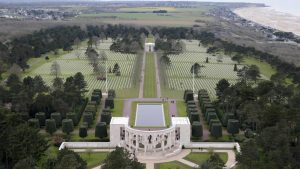Photograph of Flag Raising on Iwo Jima. Photo by Joe Rosenthal.
The US Marines in the photo above are, from left to right:
Pfc. Franklin Sousley
Pfc. Ira Hayes
Sgt. Michael Strank
Cpl. Harold Schultz
Cpl. Harold Keller
Cpl. Harlon Block
I’ve memorized their names. I first did that years ago, when I was reading James Bradley’s Flags of Our Fathers, which was about his father being in that iconic photo. But he wasn’t – that was Pfc. Schultz where they originally thought PhM2C John Bradley was. They also thought Pfc. Rene Gagnon was there, but no – that was Cpl. Keller.
James Bradley himself spoke out to get his father “demoted,” after seeing the evidence that he wasn’t in the photo. (He likely took part in an earlier flag-raising.) That’s an indication of how reverent many people are about this picture. It was an iconic image from the very moment of its release to a war-weary US public in early 1945, for whom it became an inspiration to carry through to August of that year, and the war’s end.
If you haven’t read of the horrors of Iwo Jima, I suggest you do. None of us can begin to imagine the burst of morale that arose in the American boys down below when the red, white, and blue unfurled atop Mt. Suribachi. For them, too, it was an inspiration.
For half of those boys in the photo above, it was the waning days of their time here on earth. Pfc. Sousley was the last of the six to fall there on the black volcanic sand, shot in the back by a Japanese sniper as the days of battle drew to a close. Sgt. Strank and Cpl Block both fell in the thick of the fight.
Ira Hayes survived the battle and the war, but not its effects. He fell into alcoholism after the hoopla of the war bond tours they put the surviving identified flag-raisers through came to an end, and after appearing with John Wayne in Sands of Iwo Jima. He died of exposure and alcohol poisoning on an early winter morning outside an abandoned adobe hut in his native Arizona.
Over 7,000 US Marines died in that one battle.
Gettysburg National Cemetery, Gettysburg, Pennsylvania. Photographer unknown.
The desperate Battle of Gettysburg in America’s Civil War marked the “high water mark” of the Confederacy. For three days the forces, neither of which wanted to fight on that ground – they were forced to after a chance encounter – fought to gain the upper hand. Had General Stonewall Jackson, General Robert E. Lee’s right-hand man, not made the fatal error of scouting in front of his own lines after the Battle of Chancellorsville, where he was shot by his own men, his genius might have changed the outcome in Pennsylvania. But instead the Union forces prevailed, winning final victory in the savage slaughter of the Confederates who launched Pickett’s Charge across an open field on the battle’s third day, right into the teeth of the dug-in Northern ranks. The loss broke the back of the Confederate forces. While the war would drag on for almost two more years, Gettysburg marked the turning point of the North’s fight to end slavery in the USA.
3,155 Union soldiers died on what President Abraham Lincoln, dedicating a portion of that battlefield for the very cemetery pictured above, said was ground consecrated by the brave men who fought there. In the whole war, 7,058 Union soldiers gave their lives that others might be free.
Normandy American Cemetery and Memorial, Colleville-sur-Mer, France. Photographer unknown.
Before I close, here’s one final bit about WWII. That hallowed ground above sits just inland from the surf of northern France. There to the right is a stretch of beach that was once designated “Omaha.” If you don’t know the harrowing story of D-Day, there’s another bit of research you really ought to do. That particular beach was the scene of the bloodiest fighting (watch the opening of Saving Private Ryan to get a sense for it) in the landings that began the liberation of Europe from the fascist nightmare.
9,385 American dead lie buried there in that stark reminder of the colossal sacrifices made by American men and women. 416,800 American died in that war.
Every American now living has the right to disrespect the flag that all the soldiers I’ve mentioned above fought and died for. It’s one of the liberties they won for you with their “blood, toil, tears, and sweat.” Shouldn’t that very reality, however, indicate to you how very wrong it is to do so? You’re protesting, you say? That just doesn’t cut it. Our soldiers didn’t put on a show, which is all you’re doing; they went and did. They did things most of us can’t even begin to imagine, just to preserve that flag. I don’t care what your grievance is. If you’re an American, they fought, and oh so many died, for you and your freedom. The very least you can do is to show the minimum respect that’s asked for that standard under which they marched, all too often to the bitter end.
Pfc. Franklin Sousley
Pfc. Ira Hayes
Sgt. Michael Strank
Cpl. Harold Schultz
Cpl. Harold Keller
Cpl. Harlon Block
Forever honor the banner they raised. Forever remember all those who gave their last full measure of devotion.
Oh say does that star-spangled banner yet wave
O’er the land of the free, and the home of the brave?
Happy Independence Day, one and all.
A postscript:



